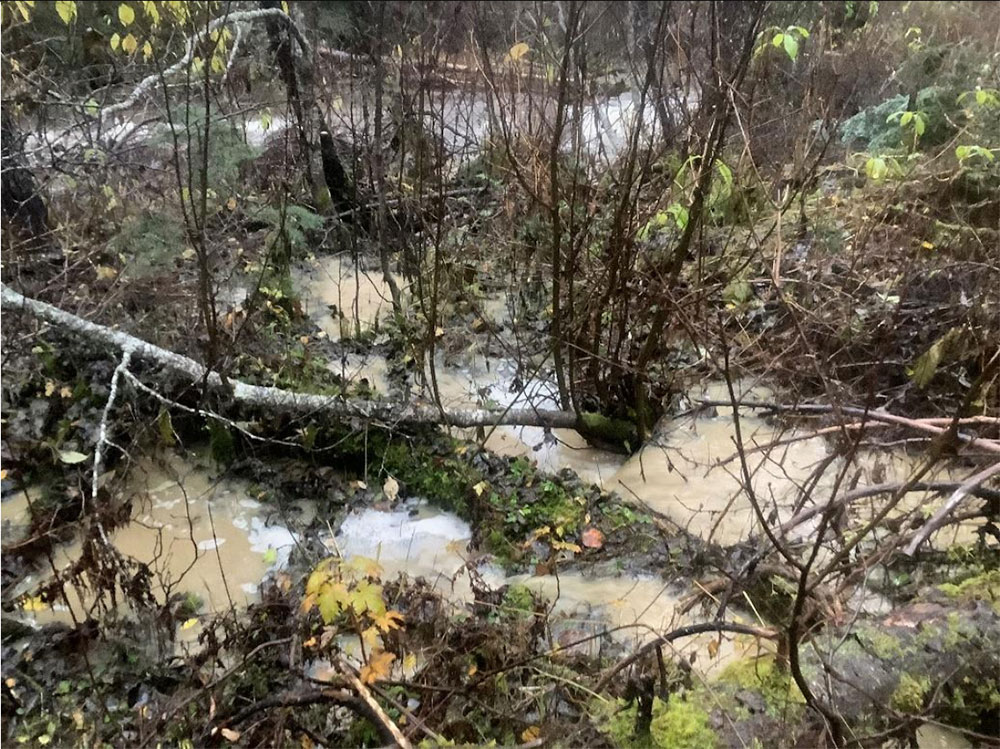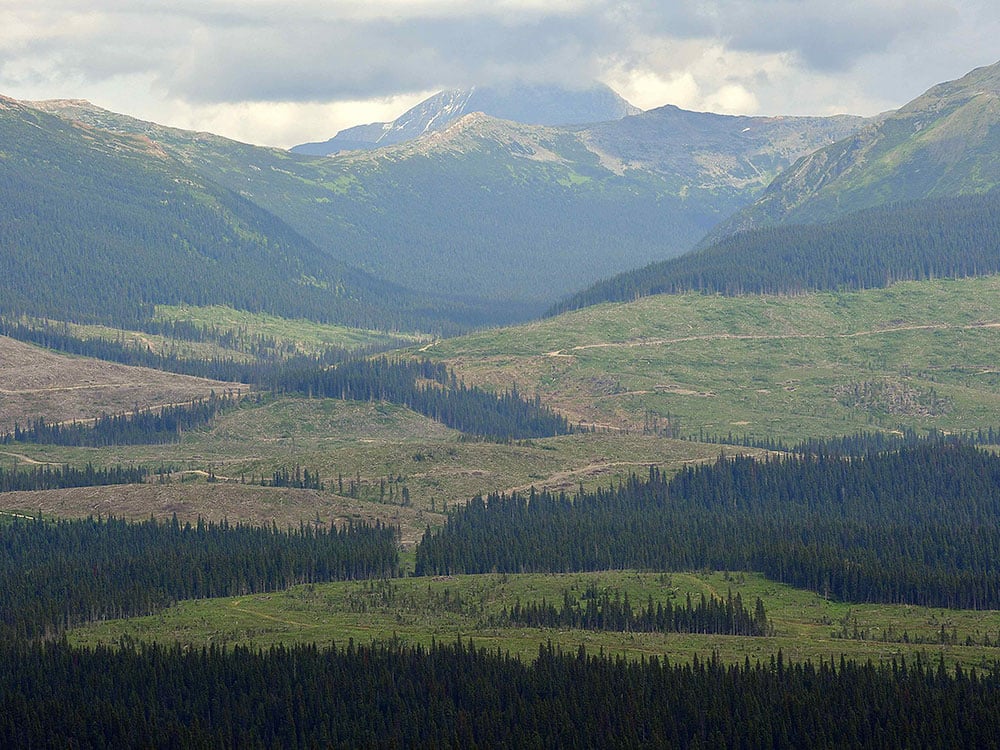Articles Menu

Oct. 27, 2022
Coastal GasLink maintains it’s not in violation of a compliance agreement it signed with the province aimed at reducing watershed damage along its pipeline route.
But the B.C. government ordered it to “cease” activities that violate the agreement on Oct. 14.
TC Energy, the parent company building the 670-kilometre gas pipeline through northern B.C., confirmed in an email to The Tyee that no work had stopped along the pipeline route.
“The EAO has confirmed that it does not expect Coastal GasLink to stop any work provided the appropriate environmental mitigation is in place in the field,” a company spokesperson said. “Coastal GasLink understands that we were and continue to be compliant with this order.”
An Environment Ministry spokesperson said inspectors found “instances of noncompliance” but added that the environment was not impacted by the infractions.
“These included work that varied from approved work plans approved by the EAO, and issues with erosion and sediment controls,” the ministry said in an email. “Once CGL fixes activities so the work follows what’s in the work plan, or revises the work plan and gets EAO approval on it, they will be in compliance and can resume work in any area where work had stopped.”
TC Energy said that the order was issued “without prior notice or explanation,” adding that it was working with the EAO to “understand the specifics behind this order.”
The ministry’s order resulted in a weekend article in the Vancouver Sun that initially reported that Coastal GasLink had been issued a stop-work order. The story was replaced hours later with one saying the company was in “hot water.” The revised story was updated to include comments from TC Energy.

It’s been two years since the EAO first identified soil erosion and sedimentation issues along the pipeline route. Since then, it has issued multiple orders and two fines totalling almost $250,000 for the ongoing issues.
On July 14, the province announced it had entered into an agreement with the company with the goal of ensuring more stringent measures to control erosion and sedimentation.
“Failure to comply with the agreement can result in escalating enforcement action, up to and including stop-work orders by the minister of Environment and Climate Change Strategy,” the province said in a news release at the time.
The agreement applies to 32 specific sections along the pipeline route that range from 65 metres to more than 18 kilometres in length. Collectively, the sections cover about 100 kilometres over a 500-kilometre stretch of the 670-kilometre route.
The agreement requires the company to have a “work execution plan” in place before clearing in those sections can begin. The plans must be developed by a qualified professional and independently reviewed before being submitted to the EAO for approval.
These plans have not been made public and TC Energy did not respond to The Tyee’s request to view its work execution plan for the Anzac River Valley.
The longest section covered by the agreement is an 18-kilometre stretch where the pipeline parallels the Morice River, known to the Wet’suwet’en Nation as Wedzin Kwa. Ongoing opposition from the nation’s hereditary leadership and its supporters have led to several high-profile police actions in recent years.
It spans the area where Coastal GasLink is currently drilling under the river.
On Oct. 5, BC Green Party MLA Adam Olsen spoke in the legislature and called on the province to issue a stop-work order against the company, noting that salmon are currently spawning in the Morice River.
“Coastal GasLink cannot be trusted to protect our environment,” said Olsen, who represents Saanich North and the Islands. He added that the company has been issued 51 warnings, 16 orders and two fines by the EAO.
“They’ve damaged wetlands, rivers and lakes along the pipeline route. Now they’re drilling just a stone’s throw away from millions of salmon eggs, imperilling an entire generation of salmon,” he said. “Everybody with any authority is just standing on the sidelines while this company — with a terrible environmental record — drills, digs and blasts under the largest remaining Chinook spawning grounds in the Skeena system.”
Olsen described a “mess of compliance and regulatory issues” with the project and accused the province of not taking responsibility.
“If this company is not in compliance with their agreements, orders and environmental regulations, the minister has a responsibility to issue a stop-work order. Will he do that today, until this company gets into compliance?” he asked in the legislature.
B.C. Environment Minister George Heyman defended the province’s work overseeing the project, saying that the EAO had conducted “multiple” inspections and investigations, as well as issued penalties against the company. He also pointed to the recent compliance agreement, saying, “We intend to ensure that the transgressions and issues of noncompliance cease.”
There’s no indication that Coastal GasLink is currently out of compliance in the section that encompasses its drilling operation under Wedzin Kwa. The drill site itself is not covered by the agreement because clearing activities had already occurred there.
The Anzac River Valley, where the province said the recent violations were identified, sits about 100 kilometres north of Prince George, between McLeod Lake and Tumbler Ridge. The watershed has experienced “aggressive” logging in recent years and a notable increase in turbidity in the watershed, says Michelle Connolly, director with Conservation North.
The community organization, which advocates on environmental issues in north-central B.C., called on the province in August to implement recommendations from a 2020 Forest Practices Board investigation that called for greater protection for old growth and biodiversity in the area.
Connolly fears that pipeline construction is adding more pressure to a watershed already heavily impacted by logging.
“The Anzac is the poster child for cumulative impacts because of the industrial logging and, of course, the pipeline,” Connolly said.
“I don’t know if there’s any way to really tease apart the impact of the pipeline, specifically, or the logging,” she said. “That’s the nature of cumulative impacts. But people were telling us that they weren’t taking care in putting the pipeline across the river.”

BC Green Party leader Sonia Furstenau, who is MLA for Cowichan Valley, told The Tyee this week she believes it will take “real consequences” to bring companies like Coastal GasLink into compliance with provincial regulations.
“The current scheme seems to create these conditions where paying fines is less expensive than adhering to the permitting conditions,” she said. “Real accountability and real consequences would mean that this company is not allowed to proceed with any further construction until they are in compliance with the entire permit.”
Furstenau also expressed concern that Coastal GasLink’s work execution plans aren’t being made public and called on the provincial government to show its work.
“Trust is the currency of democracy,” she said. “This project, in particular, came along with public subsidies. This is an example of where we should have an expectation of the highest level of transparency and scrutiny.”
Coastal GasLink’s issues with erosion and sediment control were first identified in October 2020, when the EAO determined that the company either hadn’t developed or wasn’t following site-specific plans to prevent project-runoff in five of the pipeline’s eight sections.
The EAO issued an order two months later requiring Coastal GasLink to hire an independent auditor to oversee erosion control measures meant to stem the flow of silty water into sensitive watercourses and wetlands. Since then, it has issued six additional orders against the original order, all of them for continued erosion and sediment-control issues in dozens of locations across the pipeline route.
As recently as July, just days after the province signed its compliance agreement with Coastal GasLink, EAO inspections identified more noncompliance over soil erosion and sediment-control measures. According to an inspection report posted last month, the province has recommended another penalty against the company.
The ministry said that EAO compliance and enforcement officers are continuing to “gather and evaluate” information from the inspections earlier this month.
“Additional inspections continue to take place, with compliance and enforcement officers at sites last week and this week,” it said. “They will continue to conduct spot inspections to ensure compliance with the agreement and with the requirements of the environmental assessment certificate.”
A full inspection report outlining the noncompliance that led to the recent order will be finalized and made public in the coming weeks, the ministry said
[Top photo: The Anzac River used to run clear, according to an environmental group. But this 2020 photo shows sedimentation following logging in the area. The group fears work on the Coastal GasLink pipeline could make things worse. Photo from Conservation North.]